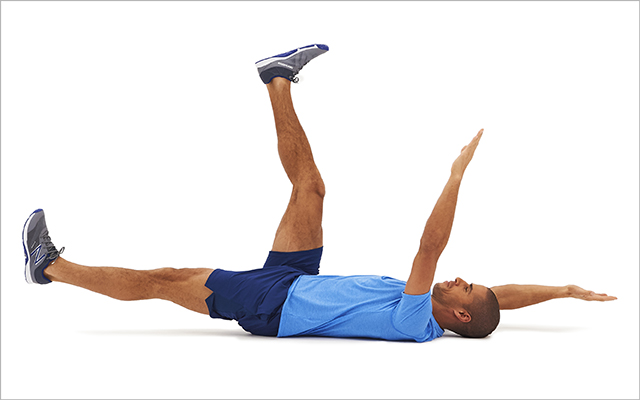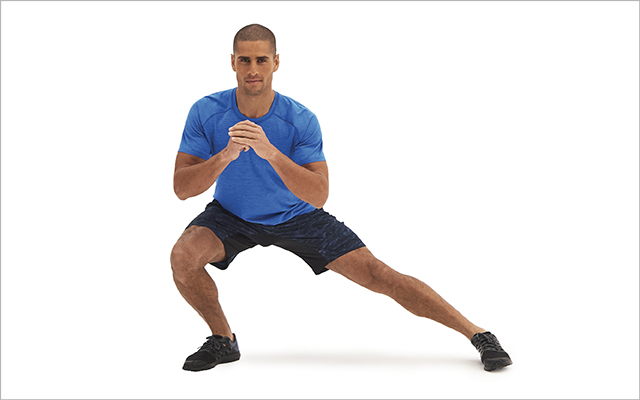The finish line is a thing of beauty. The mix of pride, relief, and joy on the faces of every weary, ecstatic finisher — from the front-runners to the courageous first-timers — is palpable and inspiring.
If you’ve followed our six-month program to this point, you’re about to have your own finish-line moment. You’ve been hard at work for five months, and now, finally, your reward is at hand: peak strength, peak endurance, peak form.
Though the end is in sight, your work isn’t done. This final month is a hybrid that includes two weeks of building volume and intensity followed by two weeks of gradual tapering.
“Your peak form will last from one to two weeks,” says program designer Troy Jacobson, senior national director of Endurance Sports Training at Life Time. During this time, you can either head to an event starting line — or simply enjoy the rewards of your hard work.
“If you time it properly, you’ll be able to perform at your highest potential in an event of your choice,” he says. So if you feel like competing at the end of the month — in, say, a run or an obstacle-course competition — go for it.
You can also return to Month 3 and repeat the tests to see how far you’ve come (“Strong, Fast, and Fit: Into the Fire (Month 3)“). Then, go to ELmag.com/strongfastfithome to find out what’s next.
Whatever adventure you choose, fist bumps and high-fives all around. You did it — congratulations!
Month 6 Overview
For the next month, your workout schedule will look like this:
| Week | Monday | Tuesday | Wednesday | Thursday | Friday | Saturday | Sunday |
|
21 |
Rest | Strength Workout A; Cardio Workout A (Zones 2-3) |
Cardio Workout A (Zones 2-3) |
Strength Workout B | Cardio Workout C (Zones 3-5) |
Strength Workout A; Cardio Workout A (Zones 2-3) |
Cardio Workout B (Zones 2-4) |
|
22 |
Rest | Strength Workout A; Cardio Workout A (Zones 2-3) |
Cardio Workout A (Zones 2-3) |
Strength Workout B | Cardio Workout C (Zones 3-5) |
Strength Workout A; Cardio Workout A (Zones 2-3) |
Cardio Workout B (Zones 2-4) |
|
23 |
Rest | Strength Workout B; Cardio Workout C (Zones 3-5) |
Cardio Workout A (Zones 2-3) |
Rest | Strength Workout C | Cardio Workout F (Zones 3-5) |
Strength Workout C; Cardio Workout E (Zones 2-4) |
|
24 |
Rest | Cardio Workout F (Zones 3-5) |
Strength Workout D; Cardio Workout D (Zones 2-3) |
Rest | Event Prep (optional) | Event/Test (optional) | Rest |
Download Image of Month 6 Overview
- Pay attention to timing. This month, the intervals in the strength workouts change from circuit to circuit and day to day. Plan ahead to know when to work and when to rest.
- On rest days, rest. This month, pay close attention to sleep, nutrition, hydration, foam rolling, stretching, and other recovery techniques.
- Find your zone. Determine your work zones by calculating your anaerobic threshold (for a DIY method, visit “How to Calculate Your Anaerobic Threshold“) or taking an individualized metabolic test (available at many health clubs). You can also use the RPE (rate of perceived exertion) scale, a subjective effort measurement, as defined below.
RPE Scale
| Zone | Percentage of Maximum Effort | How It Feels |
| 1 | 50%-60% | Very easy, possible to continue for long periods |
| 2 | 60%-70% | Easy, with light sweating |
| 3 | 70%-80% | Light muscular fatigue, moderate sweating |
| 4 | 80%-90% | Very heavy breathing, high muscular fatigue |
| 5 | 90%-100% | Maximum, all-out effort |
The Workouts
For Strength Workouts A and B, perform four rounds of each circuit. In Circuit 1, work for 30 seconds, then rest for 30 seconds, with a one-minute rest between rounds. In Circuit 2, work for 45 seconds, then rest for 30 seconds, with a one-minute rest between rounds.
For Strength Workouts C and D, the exercises are the same as in A and B, but the number of rounds and work-to-rest intervals change. Perform three rounds of each circuit, working for 20 seconds, then resting for 30 seconds between exercises, with a one-minute rest between rounds.
Strength Workouts A and C
| Circuit 1 | Circuit 2 |
| A. Burpee Mountain Climber
B. Pushup C. Self-Assisted Pull-Up D. V-Sit |
A. Jump Rope
B. Goblet Squat C. Dead Bug Leg Raise |
Strength Workouts B and D
| Circuit 1 | Circuit 2 |
| A. Dumbbell Clean and Press
B. Self-Assisted Pull-Up C. Dead Bug Leg Raise D. Pushup |
A. Jump Rope
B. Goblet Squat C. Burpee Mountain Climber |
Cardio Workout A
Perform a cardio exercise you enjoy at a steady state for 45 minutes in Zones 2–3.
Cardio Workout B
Perform a cardio exercise you enjoy at a steady state for 60–75 minutes in Zones 2–4.
Cardio Workout C
Warm up for 10 minutes with a cardio exercise you enjoy, slowly elevating your intensity to Zones 3–4. Then, perform seven 90-second intervals in Zone 5, resting for one minute between each. Finally, perform five 15-second intervals at your highest intensity, taking one minute between efforts. Cool down for 10 minutes.
Cardio Workout D
Perform a cardio exercise you enjoy at a steady state for 30 minutes in Zones 2–3.
Cardio Workout E
Perform a cardio exercise you enjoy at a steady state for 45 minutes in Zones 2–4.
Cardio Workout F
Warm up for 10 minutes with a cardio exercise you enjoy, slowly elevating your intensity to Zones 3–4. Then, perform four 45-second intervals in Zone 5, resting for one minute between each. Finally, perform three 15-second intervals at your highest intensity, taking one minute between efforts. Cool down for 10 minutes.
Event Prep Workout
About 18 to 24 hours before your event, perform five to 10 minutes of easy cardio. Then, do three to five 15-second sprints, with a one-minute rest between efforts. Finally, perform two sets of five to eight reps each of pushups, V-sits, and body-weight squats.
Month 6 Exercises
Pushup
- Assume a pushup position — hands and feet slightly wider than shoulder width, hands and the balls of your feet on the floor, arms locked out, and body straight, heels to the top of your head.
- Keeping your body straight and your head in a neutral position, simultaneously bend your arms and retract your shoulder blades until your elbows form 90-degree angles.
- Reverse the movement, pushing yourself back up to the starting position.
- Too tough? Perform the exercise with your hands elevated on a box, table, or bench. Too easy? Perform the move with your feet elevated.
Self-Assisted Pull-Ups
- Place a chair, box, or bench beneath a chin-up station, high enough so that when you stand on the bench and grasp the bar, your arms are bent.
- Stand on the box and grasp the bar with a comfortable grip.
- Simultaneously jump upward and pull yourself up with your arms until your chin clears the top of the bar.
- Hold the top position for a one-count, then slowly lower yourself back down to the bench, bending your legs slightly until your arms extend fully.
V-Sits

- Sit upright on the floor with your back long, your head in a neutral alignment and your legs together.
- Lean backward and lift your legs about 45 degrees from the floor and hold for the prescribed time period.
- Too tough? Hold as long as you can, rest for a few seconds, and repeat throughout the set.
Goblet Squat
- Stand holding a light-to-medium dumbbell, vertically, just under your chin.
- With your feet parallel and slightly wider than shoulder width, slowly bend your knees and hips, sitting back until the tops of your thighs are parallel to the floor, keeping your lower back in a natural arch throughout the movement.
- Reverse the move, slowly standing back up, and repeat.
Jump Rope

- Stand upright, holding the handles of a jump rope by your sides, with the rope hanging down behind your heels.
- Swing the rope up over your head.
- Jump over the rope as it comes toward your feet in front of you.
- Land on the balls of your feet and repeat continuously.
- Experiment with different rhythms (faster or slower) and foot patterns (skipping, hopping) as you improve.
Burpee Mountain Climber
- Assume a shoulder-width, athletic stance.
- Keeping your lower back in its natural arch, bend at the hips and knees and place your hands on the floor.
- Jump your feet backward into the pushup position: feet at shoulder width, body straight from your head to your heels, hands and the balls of your feet on the floor.
- Lift your right foot from the floor and quickly draw your right knee as close as possible toward your chest, then back to pushup position.
- Repeat the move with your left knee.
- Jump your feet forward to a squat position.
- Drop your hips, flatten your back, stand upright, and jump upward.
Dumbbell Clean and Press
- Assume an athletic stance — feet at shoulder width, back straight, gaze forward — holding medium-heavy dumbbells at your sides.
- Bend your knees slightly and then “explode” upward (as if attempting to jump straight up in the air), and simultaneously swing the dumbbells to shoulder level, keeping them close to your body as you do so.
- Slowly press the dumbbells to arm’s length overhead.
- Reverse the movement, lowering the dumbbells back to shoulder width and then back to your sides under control.
Dead Bug Leg Raise
- Lie on your back, contract your abdomen, press your lower back into the floor, and keep it there throughout the exercise.
- Extend your arms and legs straight up toward the ceiling, palms facing one another and feet flexing back toward your shins.
- Keeping the lower back firmly on the floor and all four limbs straight, slowly lower your right arm overhead and your left leg down until your thumb and your heel brush the floor.
- Reverse the movement, repeat the move with your left arm and right leg, and continue alternating sides for 30 seconds.
What’s Next?
As you come to the end of the six-month program, you might be wondering, “Now what?” The truth is, when fitness is a part of your life and an ongoing tool for physical and mental well-being, there is no “end.” Rather, you take the lessons you’ve learned and the strength you’ve gained, and apply it.
You can opt for a new program — possibly one that is focused on a sport-specific goal, such as a triathlon or powerlifting meet — or progress previous programming to suit your improved strength, speed, and endurance. The beauty of Strong, Fast, and Fit is that it is a solid template that can be repeated and progressed.
If you choose this route, repeat Month 4 for a “reset” and then go back to Month 1. Progress the moves by choosing more difficult variations, adding weight, aiming for more good-form repetitions in the time allotted, or a combination of the three.



This Post Has 0 Comments